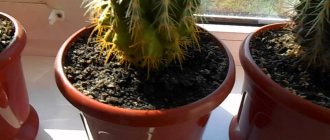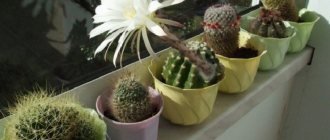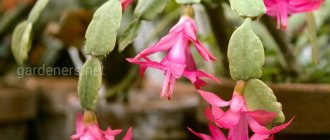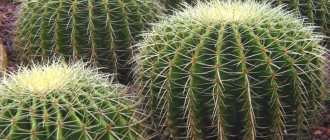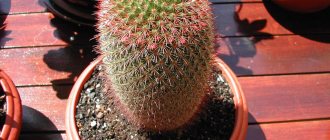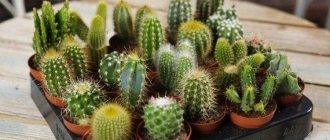Common names: Astrophytum myriostigma. Astrophytum polystylata. Bishop's cap
Family: Cactaceae
Synonyms : Astrophytum coahuilense, Astrophytum columnare, Astrophytum nuda, Astrophytum prismaticum, Echinocactus myriostigma
Plant sale
Astrophytum capricorne niveum
145 rub. 190 rub.
Astrophytum asterias ASCAP
1200 rub.
Astrophytum polystigma (myriostigma)
780 rub.
Distribution and Habitat: Astrophytum myriostigma is a species of cactus native to the highlands of northeastern and central Mexico. Astrophytums inhabit predominantly sunny southern and eastern slopes on calcareous formations, rarely growing in the north or west between white-gray stones in loose or dense vegetation, which mainly consists of a community of dry shrubs.
Description: Astrophytum myriostigma are desert cacti, each of which has an unbranched stem that is roughly spherical in shape - often becoming elongated as the plant ages (becoming cylindrical after a few years) - and which is divided into wide three to eight segments with ribs with sharp edges.
The mostly green stem does not have a thorn, but is covered with tiny tufts of silvery hairs (looking like scales or spots). They give the plant a grayish tint. In mature cacti, the lower part of the stem tends to become woody. Grows up to 70-100 cm in height and 10-2 cm in diameter.
Once the plant matures, funnel-shaped flowers emerge from areoles near the top of the stem; each flower lasts only a few days, but the plant continues to bloom throughout the spring and summer. The flowers of all forms are bright yellow and grow about 5 cm wide. These cacti can take up to six years to bloom.
Classification and description of the cactus Astrophytum myriostigma (speckled)
Plant classification
Scientific name: Astrophytum myriostigma Synonyms: Echinocactus Myriostigma, Astrophytum Columnare, Astrophytum Nuda, Astrophytum Prismaticum, Astrophytum Tulense Common name: Astrophytum myriostigma, Astrophytum speckled, Astrophytum innumerable, Astrophytum polystigma Family: Cactaceae (Cactaceae) Subfamily: Cacto ideae Genus: Astrophytum (Astrophytum)
Astrophytum myriostigma, known in the West as bishop cactus or bishop's cap, is a species of flowering cactus in the family Cactaceae. This fascinating plant is native to the highlands of central and northeastern Mexico. This thornless species grows at altitudes of 750 to 1500 meters above sea level on rocky, limestone soils. Habitat: Overgrown plains or steep slopes facing east or west.
Photo of cactus Astrophytum speckled or polystylata in the desert of Mexico
Astrophytum myriostigma or speckled is a thornless succulent plant, a columnar cactus when young has the appearance of a small spherical plant with usually 5, sometimes 4 (or 3) well-formed ribs, which increase with age to eight or more (rarely even 10). The cross-section of the stem resembles a perfect star shape, giving the plant the appearance of a bishop's miter (hence the name bishop's cap).
The stem of the cactus takes on a shape from spherical to cylindrical; at age it grows to 60-100 cm in height (sometimes up to 1.5 m) and 10-20 cm in diameter. The color is bright green, covered with many small white hairy scales that give it a characteristic silvery-white appearance. The scales consist of very fine intertwined hairs. The roots of Astrophytum speckled are thin and fibrous.
The stem is globose to cylindrical, bright green and covered with many tiny white hairy scales. The cactus grows up to 1 m in height and up to 20 cm in diameter. Young plants have a spherical shape, resembling a ball. However, as the plants grow, they develop white hairy scales at the edges, turning into a star shape with 5 protruding ribs. They resemble the episcopal miter, which is the traditional headdress of bishops. This is where the common name for the cactus in Western countries comes from - episcope's cap.
However, please note that the number of ribs may vary. Many plant cultivars may have only 2-3 ribs, and in more rare cases, up to 10 ribs. The growth rate of cactus is slow and the plant takes a long time to grow and produce flowers.
Blooming cactus Astrophytum myriostigma
The glossy yellow daisy-like flower of Astrophytum myriostigma adds to the beauty of the plant. The flower emerges from the areoles at the tip of the stem of a mature plant and is usually no more than 5 cm in diameter and up to 7 cm long. Flowering lasts approximately 2 days.
Yellow flowers with red or orange centers appear in spring or early summer. Despite the slow growth rate, with proper care, even young plants can bloom. Astrophytum flowers have a faint sweet smell. The fruits are up to 2.5 cm in diameter, greenish to brownish-red in color, covered with brown, overlapping scales with long hair in the axils.
Astrophytum stellata: varietal varieties
Cactus breeders all over the world have bred many cultivars of this species (more than 100). On the Internet you can find photos of stunning colors and forms of cultivars of this amazing cactus. Let us describe the brightest artificially bred varieties of Astrophytum asterias.
Astrophytum asterias 'Super Kabuto'
Known for its unique fluffy epidermis, it is the most popular variety of this type of cactus. It is easily distinguished from ordinary Astrophytum asterias by its epidermis, which does not have simple dots, but is a mosaic of extensive white spots that make the plant look very spotted.
"Superkabuto" came about due to a mutation that occurred in nature. Reproduction was made possible by cross-pollination of this mutant plant with other common A. asterias.
Astrophytum asterias cv. Ooibo Kabuto
A Japanese variety, very similar to the common Astrophytum asterias, but has very large, characteristic and woolly areoles.
The color of the hairs varies from pure white to pastel, yellowish, orange or brownish. It is easily distinguished from natural cacti, which have relatively small, barely fluffy gray-white areoles.
Astrophytum asterias var. nudum
This varietal variety has a characteristic bare stem without the white tufts of loose hairs typical of common Astrophytum asterias. Fluffy areolas are visible on the smooth green epidermis.
During the cold, dry winter dormancy, plants often take on a beautiful red color.
How to grow Astrophytum polystigma or myriostigma
Thanks to their amazing appearance and variety of cultivars, these cacti are indispensable in any cactus lovers' collection. They are suitable for both indoor and outdoor growing. Most often grown as indoor plants. Let's figure out how to plant and care for the Astrophytum polystylata plant.
Location in the house and lighting
Speckled Astrophytum needs full sun, especially in summer. The cactus enjoys being outdoors in full sun, something that many other plants cannot tolerate. But when taking it outside, protection from rain is highly recommended. In the spring, when you take the cactus outside, you need to accustom it to the sun so that the flower does not get burned.
The best place in the house would be a south window. As much light as possible is also a desirable condition during the dormant period.
Priming
The content of organic nutrients in the soil should be kept to a minimum, since humus does not form in the desert. It is important to avoid waterlogging; therefore, the soil should be well-drained. Use a mineral, well-permeable substrate with a small amount of organic matter (peat, humus). Plants may become overly stretched if there is a lot of compost in the soil.
Temperature
The desert catus Astrophytum myriostigma is accustomed to summer temperatures of about 30 °C. The dormant period occurs from November to March, the optimal temperature at this time is about 10 °C. Astrophytum polystylata is able to withstand frosts down to -6°C for a short time.
Watering and humidity
During the growing season - from spring to autumn, Astrophytum myriostigma should be maintained in moderately moist soil. The top layer of soil should always dry well between waterings; a few hot days without moisture are not a problem for it. As soon as temperatures begin to drop in the fall, stop watering until spring. You can also water cacti from below (from the cup holder). Water is drawn into the ground through the drainage holes and rises to the surface of the pot. Any remaining water must always be removed.
Description of the plant
Astrophytum got its name because of its unusual shape. If you look at it from above or in section, you can clearly see the shape of a star. In young plants the stem is spherical, but over time it becomes cylindrical. The number of strongly pronounced hard ribs depends on the species; there can be from three to eight.
Flowering of astrophytum begins in late spring or mid-summer and lasts until October. One flower lives for three days, after which others bloom. The flowers are predominantly yellow; sometimes their base has a red tint or there are red streaks on the petals. Flowers bloom on the top of the plant, their size is from 4 to 8 cm. In place of the withered flower, a fruit-box with seeds is formed. The seeds are easy to germinate.
How to propagate Astrophytum myriostigma
Photo of young Astrophytum speckled cacti grown from seeds
- It is best to propagate Astrophytum plants by seeds.
- Use sandy and well-drained soil for propagation. Lightly press the seeds into the soil. Keep the soil temperature around 25°C, keeping it slightly moist.
- As they germinate, move the young seedlings into separate pots. The ideal soil for young plants is a mixture of 25% coarse sand, 25% pumice and 50% soil mix. Also remember to sprinkle the surface of the soil with a thin layer of sand.
- It is advisable to provide young plants with as much light as possible. Keep them away from direct sunlight and excessively high temperatures as they are still too fragile to withstand such conditions.
Reproduction of Astrophytum stellata
This type of cactus does not produce lateral branches (babies) and is a single-stem plant. The only method of propagation of Astrophytum stellata is by seeds. Seeds should be planted immediately after they are collected to increase the chances of germination.
Photo of young shoots of Astrophytum asterias
Plant the seeds in trays with well-aerated soil. Remember to keep the soil moist from germination until they are ready to transplant. When the sprouts become visually visible, move them to a well-lit area. But be careful! Keep them out of the midday sun and give them shade from time to time. Watering from above is also prohibited. Try to wet the soil from below, through the drainage hole, to avoid damaging the tender young star cacti.
Transplanting into separate pots should be done when the sprouts reach a height of 1.5 cm.
Pests and diseases of Astrophytum speckled
A flower in a properly provided environment should be protected from pests, especially if they are grown in an optimal mineral soil mixture, with good lighting and ventilation. However, the cactus can attract various pests that you should pay attention to:
- Spider mite. These pests can be effectively removed by gently watering infested plants from above;
- Mealybugs. Felt weeds can sometimes cause problems with ugly results, but the worst case scenario is that they are a pest on the roots and out of sight.
- Rot. Only a minor problem for cacti. The main thing is prevention - plants need to be properly watered and “ventilated”. Otherwise, fungicides won't help much.
The appearance of brown spots on young plants indicates that the soil is too wet. It is best to stop watering the plant. If necessary, instead of watering the soil, place the pot in a tray of water and let the plant absorb all the necessary water in about 30 minutes.
Landing
Cacti are planted in small pots slightly larger than the diameter of the base of the plant. The soil should be neutral or slightly alkaline; acidic soil is destructive for astrophytum.
Soil composition:
A drainage layer must be laid at the bottom of the pot. It is impossible to bury the base of the stem, as this can cause it to rot. The soil surface is covered with very small pebbles or decorative stones. This is necessary in order to avoid contact of the cactus stem with the soil.
Caring for astrophytums is somewhat different from caring for ordinary cacti.
Astrophytum loves lime water, so there is no need to settle it before watering.
Watering is carried out only when the entire lump of earth has dried out. The water should not be too cold.
When the dormant period begins, the temperature in the room is lowered and watering is stopped. Cacti do not require special attention at this time, but astrophytums need to be looked after: if the stem begins to shrink and wither, you should water it with a small amount of water.
If in winter it is not possible to lower the temperature at home, then watering is carried out in the same way as in summer - after the earthen clod has completely dried.
Astrophytum from seeds at home
Astrophytum fruit and seeds photo
Astrophytum does not produce shoots for vegetative propagation; it can be grown exclusively from seeds. When choosing them in a flower shop, pay attention to the expiration dates, since germination lasts no more than two years. Sow in spring.
One-month shoots of astrophytum photo
Three-year-old astrophytums from seeds photo
Growing conditions
Illumination
All types and varieties of astrophytum are photophilous. To ensure sufficient lighting, place the flower pot on a south or southeast facing window. On hot summer days, it is better to shade at midday: lean a sheet of paper against the window or leave the blinds half-closed. Does not suffer from seasonal reduction in lighting; artificial supplementary lighting is not required.
Air temperature
In spring, it feels great at room temperature, which is comfortable for humans. During the summer season, it is recommended to take it out into the fresh air (on the balcony, loggia, terrace), protecting it from precipitation. If this is not possible, try to ventilate the room more often. Wintering must be cool, otherwise flower buds will not develop. From late autumn, keep it in the temperature range of 10-12 °C.
How to care?
The Astrophytum genus is easy to care for, and its requirements for the environment are almost the same as those of most other domestic cacti.
- Growing temperature : 20–25 degrees and approximately 10 degrees in winter. Astrophytum needs a sharp daily temperature difference, because in the deserts where it comes from, it is hot during the day and very cold at night, such conditions are most familiar to it.
- Reproduction methods : in spring, seeds (collected at the end of summer from fruits formed after flowering) are planted in the ground and left in a dark place at a temperature of 20–22 degrees until sprouts appear. As soon as they sprout, the container should be moved to a window where there is a lot of sunlight, and the soil should be constantly kept moist (but not over-watered). When the cactus has formed into an adult plant with hard lateral ribs, spines have formed on it (if the variety implies their presence), watering should be reduced several times. If several seeds were planted in one container, then as the plants grow, they need to be replanted.
- Lighting : loves bright light, tolerates direct sunlight. In winter it needs additional lighting.
- Watering : rare. In summer, you need to water when the soil is completely dry, in winter even less often - only when the plant begins to dry out. It is advisable to pour water into a pan rather than directly into the ground. Moisture should not get on the stem, especially on its lower part, otherwise it will begin to rot. You can use hard lime water; it is not necessary to settle it.
Reference! Astrophytum does not tolerate high humidity, even at an average level it may be uncomfortable. Due to the abundance of moisture, it fades and rotting begins.
- Soil : practically undemanding to soil, accustomed to sandy and rocky soils, so you can add sand and brick chips to any ready-made soil mixture. You can make the soil yourself by mixing peat, turf and deciduous soil. Does not tolerate high acidity, slightly acidic or neutral soil is preferred.
- Feeding : in the spring, astrophytum begins a period of active growth, and during this period it needs fertilizer. Any of the mineral complexes for cacti will be suitable in an amount of 1/2 of the dose recommended on the package. Fertilizer is added to the soil about once a month from early spring to mid-summer, then feeding stops until next year.
- Flowering : Blooms annually in summer, but only under ideal conditions. The appearance of the flowers and the duration of flowering depend on the variety. Closer to autumn, seeds appear that need to be collected - you can save them for planting, or you can throw them away. If you leave them until they fall off on their own, they can get into the soil and rot there.
- Transplanting seedlings : only required when you need to transplant young plants that have sprouted from seeds, or when absolutely necessary (for example, moving to a larger pot). In general, it does not tolerate transplantation well, but if it is still required, then it must be carried out with maximum preservation of the earthen coma, without disturbing the roots.
Botanical description and homeland of the plant
Astrophytum or star cactus is a unique succulent native to the southern United States and northern Mexico. The plant is a star of a round shape, the ribs are clearly expressed, there are 5 or more of them. This cactus is characterized by the presence of many light specks on the surface of the stem - these are tufts of hairs capable of absorbing moisture from the air. Only some species have long spines along the edges of the ribs. The rest, due to their gray skin tone and lack of needles, look like scattered stones that are surprisingly blooming.
Astrophytum bloom
From spring to autumn, buds appear at the top of the shoot from the areola. The peduncle is short, thick, covered with felt pubescence. The corollas look like gerberas. Petals are 4-10 cm long, simple or can be double. The color scheme includes various shades of yellow. An individual flower lives no more than three days.
Despite the slow growth, the flowering period begins early, and replanting is required once every 4-5 years. Astrophytums are not difficult to grow in culture. Take moderately nutritious soil for growing: add garden lime and charcoal to the lumpy clay soil. You can also graft onto Echinopsis. Summer moderate watering alternates with absolute dry soil in winter at a temperature of 6 °C.


